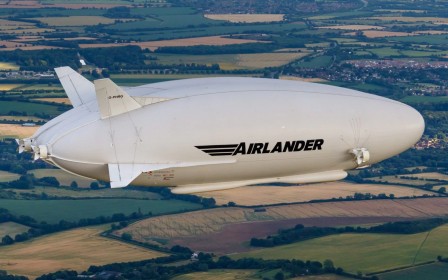Air Travel using High Altitude Balloons
Posted on Tuesday 15 September 2020, 07:53 - updated on 05/07/21 - Tech - Permalink
- Article
- |
- Comments (0)
- |
- Attachments (0)
 As fuel use drops to a trickle of what’s been typical since the end of World War II, both motor vehicle and aircraft transportation will decrease in the same way. Overland transport will return steadily with a different method of powering personal vehicles – electricity generated a new way - and rail transport will go on, with its share of ups and downs. Volume will drop as the need to commute to jobs, see customers, shop, visit and generally use vehicles for on-demand transportation fall away. Rail transport using electrical lines will be the preferred choice for long distance and interstate movement. Air travel for military purposes will remain as today but will also drop off significantly as the ability to exert armed force is lost. The defensive need for military aircraft will be much less.
As fuel use drops to a trickle of what’s been typical since the end of World War II, both motor vehicle and aircraft transportation will decrease in the same way. Overland transport will return steadily with a different method of powering personal vehicles – electricity generated a new way - and rail transport will go on, with its share of ups and downs. Volume will drop as the need to commute to jobs, see customers, shop, visit and generally use vehicles for on-demand transportation fall away. Rail transport using electrical lines will be the preferred choice for long distance and interstate movement. Air travel for military purposes will remain as today but will also drop off significantly as the ability to exert armed force is lost. The defensive need for military aircraft will be much less.
How will long distance intercontinental travel take place?
The Earth uses 24 hours to rotate once; the 24,900mi /40,100km pass by at 1,038 mph/1,670 kph. This means hovering over a fixed point and allowing the Earth to rotate below will bring the destination faster – in fact almost twice as fast – as a commercial jets now travel, which cruise at 550mph/885kph.
You might believe this is impossible; the atmosphere moves with the Earth so we must overcome wind. That’s true if we stay IN the atmosphere; if we rise above it, where there is very little, it will be much easier.
How do we rise above the atmosphere? A balloon vessel (BV). Above 100,000 ft/31,000m and there is very little air; most of the atmosphere – almost 97 % of it – is below that altitude.
Because aircraft must resist the stress of wind force, wing and fuselage structures are high strength. A balloon suspended vessel will only require a structure to contain the pressurized air within; this still requires a strong design. Absent the stress of sea level to 30-40,000 ft flight, the vessel can be built far lighter than any aircraft in use today. Lightweight, strong materials such as magnesium and titanium will be used. Because no jet fuel is present and heat from its combustion will not be used for power, the risk of fire these metals otherwise present will be much, much less.
The BV can be inflated from compressed helium tanks; a 100,000lb/45,400kg (50 ton) vessel can be lifted very easily with a volume of 80,000 cubic meters of helium. This would be a sphere about 54m/175ft in diameter. A 200,000lb/90,800kg vessel would require 78m/256ft in diameter. This sphere is just a little larger in diameter than the wingspan of a large jet in use today. A Boeing 777 weighs at least 300,000lb/135,000 kg empty; with fuel, equipment and 20 or more tons of passengers, far more.
The passenger vessel portion would be significantly larger and more comfortable inside; it could be shaped like a rugby ball for ease of design and construction and to reduce the number of internal levels a round sphere would have. Eliminating the wing, rudder and tail assemblies of a jet - which are at least ½ the weight - will allow the same interior volume for half the weight or double the weight and more than double the interior volume. This means 200 passengers with enormous first class space, lounge areas, apartment or house sized bathroom facilities and more luggage space than is now provided.
Compressed air for breathing is easy to provide; it can be stored in tanks at 6,000 psig (pounds per square inch) of pressure or about 410 bar; an air tank half the size of the passenger compartment will allow the air to be replaced every 5 -10 minutes over an 8 hour trip. Helium for levitation will only require 5 or 6 times the balloon volume, this tank will be minuscule by comparison. Helium can be compressed like air, so 3 fills of the balloon require less than 1% of its size for storage.
Air temperature is lowest well before reaching the design altitude of the balloon and vessel and then rises again; by 100,000 to 120,000 ft in altitude, the temperature rises again to near freezing; this occurs because the sunlight is so much stronger. Photo-voltaic (PV) or solar panels atop the vessel will provide more than sufficient, steady electricity to heat the interior to comfortable temperatures.
Propulsion will employ the new electricity generation method. PV cells/panels will provide the base electricity, which will be amplified by the device to produce abundant power for direct current motors and propellers driven by them. While wind exists at high altitude, the air density is very low. Wide blade propeller turbines, with many ever increasing stages of blades - too large to work at altitudes currently used for flight - will counteract and overcome wind effects. This will allow the vessel to maintain position so the Earth rotates below. The lower altitude winds will push the ballon and vessel BV.
Returning to the surface is easy as helium will gradually released to descend. Position will be maintained using ground transponders; the BV will simply follow a north south line as the Earth rotates and the destination will arrive. Bear in mind, the BV does not travel into the wind, just alongside it. The Earth rotates at >1,000mph/1,600kph; allowing some "push" will still bring the destination at greater speed than direct flight at that destination can now achieve. From Los Angeles, California to Brisbane Australia the vertical distance is 4,244 miles; over an 8 hour flight, this is 530 miles per hour to reach a destination 6,240 miles distant, with NO FUEL.
The new method of electricity generation, adapted to the BV, will provide abundant electrical and thus propeller propulsion. Bear in mind the idea is not to propel the BV towards the destination; the Earth will bring it to the BV. The idea is to counteract windpush and travel north or south along a longitude.
The new electricity method will make this all possible. Australia will be reached from the USA in the same or less time a jet now takes, with no fuel consumption in far greater comfort. The return trip will be a little longer; however just as clean.
UPDATE: 05-07-2021
Balloons which rise to the upper levels of Earth's atmosphere (upper stratosphere, specifically) much more easily avoid wind, there isn't enough air to even have wind.
Earth's atmosphere rotates along with the planet; if it didn't, just imagine the winds. The equator moves at 1,000 mph. Even halfway between the equator and the poles, the surface is moving at half that speed, 500 mph.
These "balloons" and passenger compartments will remain stationary and allow the planet to revolve underneath them. Developing technology for pressurizing them, rising and descending and most important, moving north and south, will make the procedure uncomplicated.
Here's an example of a long trip, Vancouver Canada across the Pacific to Melbourne, Australia. As the balloon rises, it is "pushed" along with the atmosphere and remains above its starting point, until the atmosphere thins out enough.
The distance is about 8,200 miles in a straight line, heading southwest. All the balloon has to do is move straight south 5,800 miles. Without air resistance, this is easily done with magnetism. In five hours and about 48 minutes, the Australia destination will pass right below. Commercial jets need more than 15 hours to make this trip; it's a long, long ride.
The advantages are no fuel, turbulence, noise or crashes. The "balloon" will have to adjust its trajectory once it's high enough, but the ability to navigate with magnetism is technology that's coming just around the corner. Our ET visitor cousins will help us, as soon as we're listening. As soon as we overcome the mass freak-out.
It will be available as a curiosity in our lifetime but not commercially available in our lifetime. We will observe, as humans, the development of this process as a curiosity.



